Themed collection JMC A Top Picks collection: Harnessing the power of the sun

Recent advances in TiO2-based photocatalysis
This article selectively discussed recent advances in TiO2-based photocatalysis from the aspects of light absorption, charge separation, and surface reactivity.
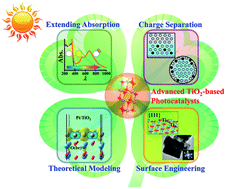
J. Mater. Chem. A, 2014,2, 12642-12661
https://doi.org/10.1039/C4TA00941J
A review on counter electrode materials in dye-sensitized solar cells
An up-to-date review on the materials used as counter electrodes in dye-sensitized solar cells.
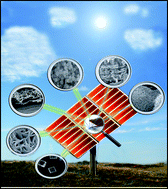
J. Mater. Chem. A, 2014,2, 4474-4490
https://doi.org/10.1039/C3TA13374E
Photocatalytic materials: recent achievements and near future trends
Evolution of the titania predominance in the scientific literature on photocatalysis estimated as the percentage of articles devoted to TiO2 among those related to oxide semiconductors or out of all the photocatalysts.
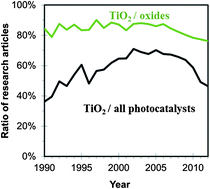
J. Mater. Chem. A, 2014,2, 2863-2884
https://doi.org/10.1039/C3TA13793G
Recent advances of non-fullerene, small molecular acceptors for solution processed bulk heterojunction solar cells
Highlights of recent research in the development of non-fullerene, small molecule acceptors for solution processed organic solar cells.
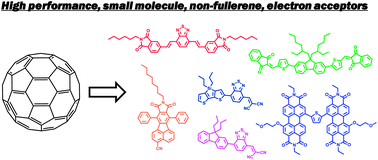
J. Mater. Chem. A, 2014,2, 1201-1213
https://doi.org/10.1039/C3TA14236A
Perovskite-based solar cells: impact of morphology and device architecture on device performance
This review provides an overview of factors affecting film morphology and how together with device architecture they impact perovskite cell performance.
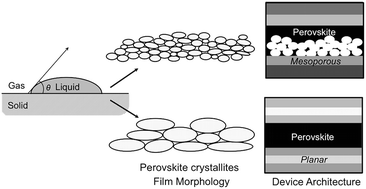
J. Mater. Chem. A, 2015,3, 8943-8969
https://doi.org/10.1039/C4TA05226A
Review of recent progress in chemical stability of perovskite solar cells
The understanding of how the chemical stability of PSCs is affected by oxygen and moisture, UV light, the solution process, and temperature was reviewed.
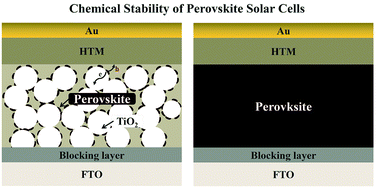
J. Mater. Chem. A, 2015,3, 8970-8980
https://doi.org/10.1039/C4TA04994B
Halide perovskite materials for solar cells: a theoretical review
First-principles calculations help to understand the fundamental mechanisms of the emerging perovskite solar cells and guide further developments.
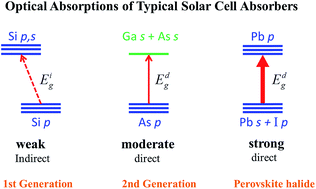
J. Mater. Chem. A, 2015,3, 8926-8942
https://doi.org/10.1039/C4TA05033A
Engineering heterogeneous semiconductors for solar water splitting
Recent progress and strategies toward solar water splitting over heterogeneous semiconductors are reviewed and the challenges and future perspectives are suggested.
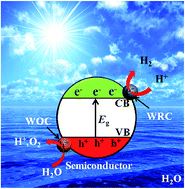
J. Mater. Chem. A, 2015,3, 2485-2534
https://doi.org/10.1039/C4TA04461D
The roles of alkyl halide additives in enhancing perovskite solar cell performance
C–X bond of alky halide additives cleavages during thermal annealing, resulting in frees halide ions to participate in perovskite formation.
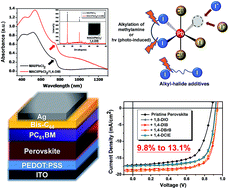
J. Mater. Chem. A, 2015,3, 9058-9062
https://doi.org/10.1039/C4TA05012F
Degradation observations of encapsulated planar CH3NH3PbI3 perovskite solar cells at high temperatures and humidity
The stability of encapsulated planar-structured CH3NH3PbI3 (MAPbI3) perovskite solar cells (PSCs) was investigated under various simulated environmental conditions.
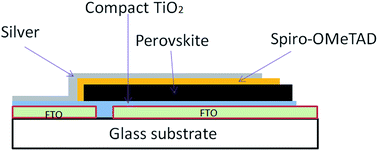
J. Mater. Chem. A, 2015,3, 8139-8147
https://doi.org/10.1039/C5TA00358J
In situ synthesis of a C-doped (BiO)2CO3 hierarchical self-assembly effectively promoting visible light photocatalysis
By combination of carbon doping and structural optimization, C-doped (BiO)2CO3 microspheres exhibited highly enhanced and stable visible photocatalytic activity.
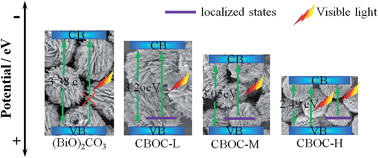
J. Mater. Chem. A, 2015,3, 6118-6127
https://doi.org/10.1039/C5TA00103J
CuInSe2 and CuInSe2–ZnS based high efficiency “green” quantum dot sensitized solar cells
The CISe-based QDs with ZnS alloy configuration exhibit higher superior optoelectronic properties and chemical stability, and thus the fabrication of CISe–ZnS QDSCs shows better photovoltaic performance.
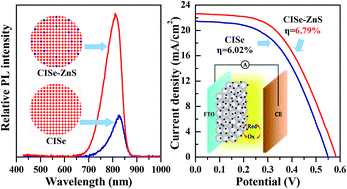
J. Mater. Chem. A, 2015,3, 1649-1655
https://doi.org/10.1039/C4TA05134C
Origin of the increased open circuit voltage in PbS–CdS core–shell quantum dot solar cells
The physics of PbS–CdS core–shell QDs is investigated, to enlighten the origin of the enhanced VOC in solar cells.
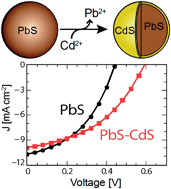
J. Mater. Chem. A, 2015,3, 1450-1457
https://doi.org/10.1039/C4TA04785K
Photogenerated electron reservoir in hetero-p–n CuO–ZnO nanocomposite device for visible-light-driven photocatalytic reduction of aqueous Cr(VI)
A 3D CuO–ZnO p–n junction hierarchical device was fabricated via sequential in situ crystallization and hydrothermal reaction on Cu foil and exhibited enhanced visible light photocatalytic reduction with stable recyclability to Cr(VI).
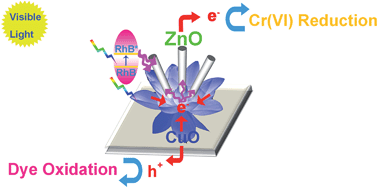
J. Mater. Chem. A, 2015,3, 1199-1207
https://doi.org/10.1039/C4TA04526B
Planar heterojunction perovskite/PC71BM solar cells with enhanced open-circuit voltage via a (2/1)-step spin-coating process
A two-step spin-coating process was used to synthesize perovskite films at ambient conditions. Combining a PEDOT:PSS hole-transport layer and a PC71BM acceptor, the device achieves a power conversion efficiency of 16.31% with a remarkably high Voc of 1.05 V and FF of 0.78.
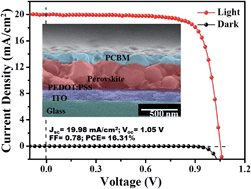
J. Mater. Chem. A, 2014,2, 15897-15903
https://doi.org/10.1039/C4TA03674C
Microwave-assisted hydrothermal synthesis of graphene based Au–TiO2 photocatalysts for efficient visible-light hydrogen production
Au–TiO2–graphene photocatalysts display high visible-light hydrogen production activity due to the load of Au nanoparticles and introduction of graphene.
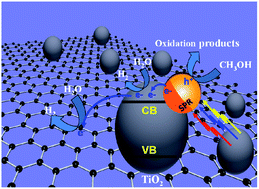
J. Mater. Chem. A, 2014,2, 3847-3855
https://doi.org/10.1039/C3TA14908K
Carbon quantum dots/TiO2 composites for efficient photocatalytic hydrogen evolution
Chemically bonded carbon quantum dots (CQDs)/TiO2 composites prepared via a one-step hydrothermal reaction exhibited enhanced photocatalytic H2 evolution activity under UV-Vis and visible light irradiation due to the dual roles of the CQDs.
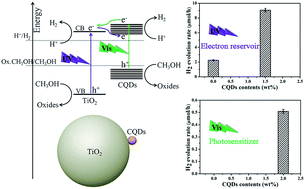
J. Mater. Chem. A, 2014,2, 3344-3351
https://doi.org/10.1039/C3TA14108J
A noble metal-free reduced graphene oxide–CdS nanorod composite for the enhanced visible-light photocatalytic reduction of CO2 to solar fuel
RGO–CdS nanorod composites, prepared by a one-step route, demonstrate high activity for the visible-light photocatalytic reduction of CO2 to CH4.
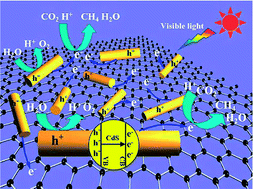
J. Mater. Chem. A, 2014,2, 3407-3416
https://doi.org/10.1039/C3TA14493C
Study on the stability of CH3NH3PbI3 films and the effect of post-modification by aluminum oxide in all-solid-state hybrid solar cells
Post-modification by Al2O3 could improve the degradation of CH3NH3PbI3 and retard electron recombination in all-solid-state solar cells.
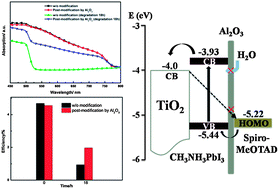
J. Mater. Chem. A, 2014,2, 705-710
https://doi.org/10.1039/C3TA13606J
Band gap engineered TiO2 nanoparticles for visible light induced photoelectrochemical and photocatalytic studies
Modified TiO2 nanoparticles for visible light-induced photocatalytic activities.
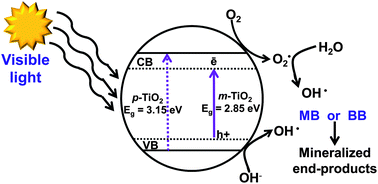
J. Mater. Chem. A, 2014,2, 637-644
https://doi.org/10.1039/C3TA14052K
About this collection
This first in a series of JMC A Top Picks collections focusses on ways in which the world’s hottest materials chemists harness the power of the sun for energy and sustainability.
The journal’s Deputy Editor-in-Chief Hiroshi Imahori (Kyoto University, Japan) has gathered together the journal’s most outstanding recent papers in solar driven technologies with crucial real world applications, such as clean generation of fuels, removing pollutants from our environment and reducing harmful emissions.
Browse this collection to view reviews and original research demonstrating the use of materials to capture the clean and inexhaustible energy of the sun. With the increasing importance of addressing environmental issues caused by mass consumption of fossil fuels, as well as concerns that the world’s limited energy resources are increasingly stretched by continuous growth in our population and economy, these are key contributions to the field for now and the future.